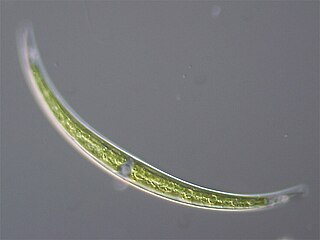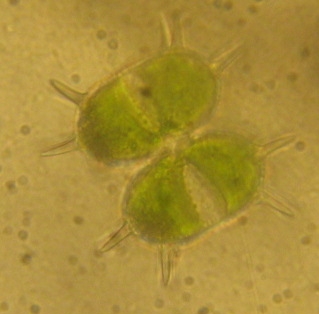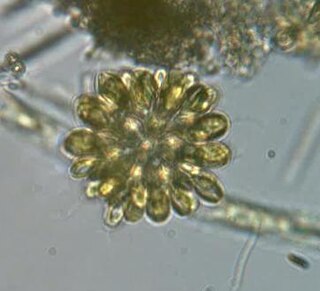
A diatom is any member of a large group comprising several genera of algae, specifically microalgae, found in the oceans, waterways and soils of the world. Living diatoms make up a significant portion of the Earth's biomass: they generate about 20 to 50 percent of the oxygen produced on the planet each year, take in over 6.7 billion tonnes of silicon each year from the waters in which they live, and constitute nearly half of the organic material found in the oceans. The shells of dead diatoms can reach as much as a half-mile deep on the ocean floor, and the entire Amazon basin is fertilized annually by 27 million tons of diatom shell dust transported by transatlantic winds from the African Sahara, much of it from the Bodélé Depression, which was once made up of a system of fresh-water lakes.

Desmidiales, commonly called the desmids, are an order in the Charophyta, a division of green algae in which the land plants (Embryophyta) emerged. Desmids consist of single-celled, microscopic green algae. Because desmids are highly symmetrical, attractive, and come in a diversity of forms, they are popular subjects for microscopists, both amateur and professional.

Prasiola is a genus of fresh water and marine green algae. Each individual plant is small but they usually grow side by side to form a green turf on rock surfaces. The genus has a cosmopolitan distribution.

The Coscinodiscophyceae are a class(s) of diatoms. They are similar to the Centrales, a traditional, paraphyletic subdivision of the heterokont algae known as diatoms. The order is named for the shape of the cell walls of centric diatoms, which are circular or ellipsoid in valve view. The valves often bear radially symmetrical ornamental patterns that can appear as dots when viewed with an optical microscope. Some also bear spines on their valves, which may either increase cell surface area and reduce sinking, or act as a deterrent to zooplankton grazers. Unlike pennate diatoms, centric diatoms never have a raphe.

Sorastrum is a genus of green algae in the family Hydrodictyaceae. It is a component of the phytoplankton of freshwater ponds, lakes, and ditches. Sorastrum is common in tropical to temperate regions of the world, but due to its small size it is often overlooked.

Stephanosphaera is a genus of green algae in the family Haematococcaceae, containing the single species Stephanosphaera pluvialis. It forms colonies of flagellated cells. Although it was once placed in the family Volvocaceae, it is not closely related to them; its sister is the unicellular genus Balticola.

Closterium is a genus of desmid, a group of charophyte green algae. It is placed in the family Closteriaceae. Species of Closterium are a common component of freshwater microalgae flora worldwide.

Cosmarium is a genus of freshwater organisms belonging to the Charophyta, a division of green algae from which the land plants (Embryophyta) emerged.
Spinoclosterium is a genus of green algae, specifically of the Closteriaceae. It is rare, but widely distributed in freshwater regions throughout the world.

Triploceras is a genus of desmid in the family Desmidiaceae.

Xanthidium is a genus of green algae, specifically of the Desmidiaceae.

Euglenales is an order of flagellates in the phylum Euglenozoa. The family includes the most well-known euglenoid genus, Euglena, as well as other common genera like Phacus and Lepocinclis.

Zygnematophyceae is a class of green algae in the paraphylum streptophyte algae, also referred to as Charophyta, consisting of more than 4000 described species. The Zygnematophyceae are the sister clade of the land plants.
Craticula is a genus of diatom that lies on or in the top layers of sediments in the freshwater to brackish water environments it inhabits. In addition to frustule morphology the genus differs from closely related species by its sexual reproduction and movement in response to light.
Plagioselmis is a genus of cryptophytes, including the species Plagioselmis punctata.

Fragilaria is a genus of freshwater and saltwater diatoms. It is usually a colonial diatom, forming filaments of cells mechanically joined by protrusions on the face and in the center of their valves. The individual diatoms appear swollen in their centers where they are joined to the colonial ribbon. the genus grows as both plankton and benthic species, free living in colonies or epiphytic. Some species are bloom forming diatoms in eutrophic lakes. The type species is Fragilaria pectinalis Lyngbye from designating a lectotype from Conferva pectinalis O.F.Müller. The taxonomy of the genus is still uncertain.

Synura is a genus of colonial chrysomonad algae covered in silica scales. It is the most conspicuous genus of the order Synurales.
Stylobryon is a monotypic genus of golden algae in the family Dinobryaceae. It has one known species Stylobryon insignisFromental, 1874.

Peridinium willei is a species of Dinoflagellata in the family Peridiniaceae.

Prasiola calophylla is a species of algae.
















